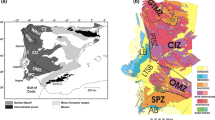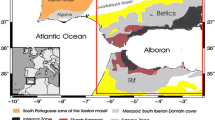Abstract
The lithospheric structure of Antarctica has been investigated from P- (PRF) and S- receiver functions (SRF) using the seismological data from Trans-Antarctic Mountain Seismic Experiment (TAMSEIS). For the stations deployed on the thick ice sheet, estimation of crustal parameters from PRF may be erroneous as the Moho conversions may interfere with the reverberations within the thick ice sheet. However, the free surface multiples are well observed in PRF. On the other hand, in SRFs, the primary conversions of interest and multiples are separated by the mother S-phase. Therefore, it is advantageous to interpret PRF and SRF jointly for the regions where we have thick low velocity layer at the top such as ice or sediments. The crustal structure and corresponding parameters have already been estimated by various workers, but here we interpret the PRF and SRF jointly to minimize the ambiguity and map the lithospheric architecture below TAM. Our analysis reveals that the average crustal thickness beneath the east Antarctica craton is ∼44 km with Vp/Vs ranging between ∼1.7 and 1.9. Below Trans-Antarctic Mountain (TAM), the average crustal thickness is ∼36 km with higher Vp/Vs of ∼1.8–2.0. The rift and the volcanic affected coastal region show erratic depths and Vp/Vs, primarily due to the absence of either primary conversion or multiples in the receiver functions. A small number of stations far from the volcano show that the crust is thinnest (∼26 to 34 km thick) in the coastal part. The contribution of this study is the mapping of the lithospheric configuration, not done so far using SRF. The SRF section along a profile spanning E-, W- Antarctica and TAM reveals that the lithospheric thickness in the coast is ∼80 km and below TAM it is ∼120 km. In the central thick ice cover region, the lithosphere thickens upto ∼150 km towards Vostok highlands. The most intriguing feature in our SRF section is that the crust and lithosphere are shallow below TAM compared to the E- Antarctica. Further, we observe a mid-lithospheric low velocity layer confined mostly below TAM, suggesting that the thermal buoyancy could be the prime cause for the upliftment of TAM.
Similar content being viewed by others
References
Bannister, S., Snieder, R.K. and Passier, M.L. (2000) Shear-wave velocities under the Transantarctic Mountains and Terror Rift from surface wave inversion, Geophys. Res. Lett., v.27, pp.281–284.
Bannister, S., Yu, J., Leitner, B. and Kennett, B.L.N. (2003) Variations in crustal structure across the transition from West to East Antarctica, southern Victoria Land. Geophys. Jour. Int., v.155, pp.870–884.
Behrendt, J.C., Lemasurier, W.E., Cooper, A.K., Tessensohn, F., Trehu, A. and Damaske, D. (1991) Geophysical studies of the West Antarctic Rift System, Tectonics, v.10, pp.1257–1273.
Behrendt, J.C. (1999) Crustal and lithospheric structure of the West Antarctic Rift System from geophysical investigations — a review, Global Planet. Change, v.23, pp.25–44.
Berg, J.H., Moscati, R.J. and Herz, D.L. (1989) A petrologic geotherm from a continental rift in Antarctica. Earth Planet. Sci. Lett., v.93(1), pp.98–108.
Bott, M.H.P. and Stern, T.A. (1992) Finite element analysis of Transantarctic Mountain uplift and coeval subsidence in the Ross Embayment, Tectonophysics, v.201(3–4), pp.341–356.
Burdick, L.J. and Langston, C.A. (1977) Modeling crustal structure through the use of converted phases in teleseismic body wave forms, Bull. Seism. Soc. Amer., v.67, pp.677–691.
Chery, J., Lucazeau, F., Daignieres, M. and Vilotte, J.P. (1992) Large uplift of rift flanks: A genetic link with lithospheric rigidity? Earth Planet. Sci. Lett., v.112, pp.195–211.
Danesi, S. and Morelli, A. (2001) Structure of the upper mantle under the Antarctic Plate from surface wave tomography, Geophys. Res. Lett., v.28, pp.4395–4398.
Dalziel, I.W.D. (1992) Antarctica:A tale of two supercontinents? Annu. Rev. Earth Planet. Sci., v.20, pp.501–526.
Farra, V. and Vinnik, L. (2000). Upper mantle stratification by P and S receiver functions, Geophys. Jour. Int., v.141, pp.699–712, doi:10.1046/j.1365-246x.2000.00118.x.
Finotello, M., Nyblade, A. Julia, J., Wiens, D. and Anandkrishnan, S. (2011) Crustal Vp-Vs tarios and thickness for Ross Island and the Transantarctic Mountain front, Antarctica. Geophys. Jour. Int., v.185, pp.85–92, doi: 10.1111/j.1365-246X.2011.04946.x.
Fitzgerald, P.G., Sandiford, M., Barrett, P.J. and Gleadow, A.J.W. (1986) Asymmetric extension associated with uplift and subsidence in the Transantarctic Mountains and the Ross Sea Embayment, Earth Planet. Sci. Lett., v.81, pp.67–78.
Frederiksen, A.W. and Bostock, M.G. (2000) Modelling teleseismic waves in dipping anisotropic structures, Geophys. J. Int., 141, 401–412.
Gupta, S., Zhao, D. and Rai, S.S. (2009) Seismic imaging of the upper mantle under the Erebus hotspot in Antarctica. Gondwana Res., v.16(1), pp.109–118.
Hansen, S.E., Julia, J., Nyblade, A.A., Pyle, M.L., Wiens, D.A. and Anandakrishnan, S. (2009) Using S-wave receiver functions to estimate crustal structure beneath ice sheets: An application to the Transantarctic Mountains and East Antarctic Craton, Geochem. Geophys. Geosyst., v.10, Q08014, doi:10.1029/2009GC002576.
Kanao, M., Shibutani, T., Negishi, H. and Tono, H. (2002) Crustal structure around the Antarctic margin by teleseismic receiver function analyses. In: J. A. Gamble, D. N. B. Skinner, and S. Henrys (Eds.), Antarctica at the Close of a Millennium. Royal Soc. New Zealand, Wellington, pp.485–491.
Kennett, B.L.N. and Engdahl, E.R. (1991) Travel times for global earthquake location and phase identification, Geophys. Jour. Int., v.105, pp.429–465, doi:10.1111/j.1365-246X.1991.tb06724.x.
Kumar, P., et al. (2005a). The lithosphere-asthenosphere boundary in the north west Atlantic region, Earth Planet. Sci. Lett., v.236, pp.249–257.
Kumar, P., Yuan, X., Kind, R. and Kosarev, G. (2005b) The lithosphere-asthenosphere boundary in the Tien Shan-Karakoram region from S receiver functions: Evidence for continental subduction, Geophys. Res. Lett., v.32, L07305, doi:10.1029/2004GL022291.
Kumar, P., Yuan, X., Kind, R. and Ni, J. (2006) Imaging the colliding Indian and Asian lithospheric plates beneath Tibet, Jour. Geophys. Res., v.111. B06308, doi:10.1029/2005JB003930.
Kumar, P., Kind, R., Priestley, K. and Dahl-Jensen, T. (2007) Crustal structure of Iceland and Greenland from receiver function studies. Jour. Geophys. Res., v.112, B03301, doi:10.1029/2005JB003991.
Kumar, P. and Kawakatsu, H. (2011) Imaging the seismic lithosphere-asthenosphere boundary of the oceanic plate, Geochem. Geophys. Geosyst., v.12, doi:10.1029/2010GC003358.
Langston, C.A. (1977) The effect of planar dipping structure on source and receiver responses for constant ray parameter. Bull. Seism. Soc. Amer., v.67, pp.1029–1050.
Lawrence, J.F., Wiens, D.A., Nyblade, A.A., Anandakrishan, S., Shore, P.J. and Voigt, D., (2006a). Crust and upper mantle structure of the Transantarctic Mountains and surrounding regions from receiver functions, surface waves, and gravity: implications for uplift models. Geochem. Geophys. Geosyst., v.7, Q10011. doi:10.1029/2006GC001282.
Lawrence, J.F., Wiens, D.A., Nyblade, A.A., Anandakrishnan, S., Shore, P.J. and Voigt, D. (2006b) Rayleigh wave phase velocity analysis of the Ross Sea, Transantarctic Mountains, and East Antarctica from a temporary seismograph array. Jour. Geophys. Res., v.111, B06302. doi:10.1029/2005JB003812.
Lawrence, J.F., Wiens, D.A., Nyblade, A.A., Anandakrishan, S., Shore, P.J. and Voigt, D. (2006c) Upper mantle thermal variations beneath the Transantarctic Mountains inferred from teleseismic S-wave attenuation. Geophy. Res. Lett., v.33, doi:10.1029/2005GL024516.
Morelli, A. and Danesi, S. (2004) Seismological imaging of the Antarctic continental lithosphere: a review. Global and Planetary Change, v.42, pp.155–165.
Ritzwoller, M.H., Shapiro, N.M., Levshin, A.L. and Leahy, G.M. (2001) Crustal and upper mantle structure beneath Antarctica and surrounding oceans. Jour. Geophys. Res., v.106, pp.30,645–30,670.
Robinson, E.S. and Splettstoesser, J.F. (1984) Structure of the Transantarctic Mountains determined from geophysical surveys, in Geology of the Central Transantarctic Mountains, Antarct. Res. Ser., vol. 36, edited by M. D. Turner and J. F. Splettstoesser, pp. 119–162, AGU, Washington, D. C.
Sieminski, A., Debyle, E. and Leveque, J.J. (2003) Seismic evidence for deep low-velocity anomalies in the transition zone beneath West Antarctica. Earth Planet. Sci. Lett., v.216, pp.645–661.
Smith, A.G. and Drewry, D.J. (1984) Delayed phase change due to hot asthenosphere causes Transantarctic uplift? Nature, v.309, pp.536–538.
Stern, T.A., and ten Brink, U. S. (1989) Flexural uplift of the Transantarctic Mountains. Jour. Geophys. Res., v.94, pp.10,315–10,330.
Studinger, M., Bell, R.E., Buck, W.R., Karner, G.D. and Blankenship, D.D. (2004) Sub-ice geology inland of the Transantarctic Mountains in light of new aerogeophysical data. Earth Planet. Sci. Lett., v.220, pp.391–408.
ten Brink, U.S. and Stern, T.A. (1992) Rift flank uplifts and hinterland basins: comparison of the Transantarctic Mountains with the Great Escarpment of southern Africa. Jour. Geophys. Res., v.97, pp.569–585.
ten Brink, U.S., Bannister, S., Beaudoin, B.C. and Stern, T.A. (1993) Geophysical investigations of the tectonic boundary between East and West Antarctica. Science, v.261, pp.45–50.
ten Brink, U.S., Hackney, R.I., Bannister, S., Stern, T.A. and Makovsky, Y. (1997) Uplift of the Transantarctic Mountains and the bedrock beneath the East Antarctic ice sheet. Jour. Geophys. Res., v.102, pp.27,603–27,621.
van der Beek, P., Cloetingh, S. and Andriessen, P. (1994) Mechanisms of extensional basin formation and vertical motions at rift flanks: Constraints from tectonic modeling and fission track thermochronology. Earth Planet. Sci. Lett., v.121, pp.417–433.
Vinnik, L.P. (1977) Detection of waves converted from P to SV in the mantle. Phys. Earth Planet. Int., v.15, pp.39–45.
Watson, T., Nyblade, A., Wiens, D.A., Anandakrishnan, S., Benoit, M., Shore, P.J., Voigt, D. and Vandecar, J. (2006) P and S velocity structure of the upper mantle beneath the Transantarctic Mountains, East Antarctic craton, and Ross Sea from travel time tomography, Geochem. Geophys. Geosyst., 7, Q07005, doi:10.1029/2005GC001238.
Wessel, P. and Smith, W.H.F. (1995) New version of the Generic Mapping Tools released, Eos Trans. AGU, 76, 33, doi:10.1029/95EO00198.
Windley, B.F. (1995) The Evolving Continents, 3rd Ed. John Wiley and Sons, UK. 526p.
Yuan, X., Ni, J., Kind, R., Mechie, J. and Sandvol, E. (1997) Lithospheric and upper mantle structure of southern Tibet from a seismological passive source experiment. Jour. Geophys. Res., v.102, pp.27,491–27,500, doi:10.1029/97JB02379.
Zandt, G. and Ammon, C.J. (1995) Continental crust composition constrained by measurements of crustal Poisson’s ratio, Nature, v.374, pp.152–154.
Zhu, L. and Kanamori, H. (2000) Moho depth variation in southern California from teleseismic receiver functions. Jour. Geophys. Res., v.105, pp.2969–2980.
Author information
Authors and Affiliations
Corresponding author
Rights and permissions
About this article
Cite this article
Kumar, P., Talukdar, K. & Sen, M.K. Lithospheric structure below transantarctic mountain using receiver function analysis of TAMSEIS data. J Geol Soc India 83, 483–492 (2014). https://doi.org/10.1007/s12594-014-0075-5
Received:
Accepted:
Published:
Issue Date:
DOI: https://doi.org/10.1007/s12594-014-0075-5




